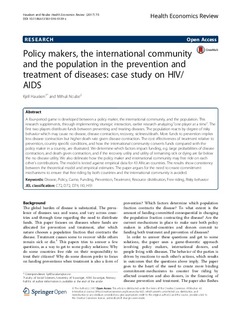| dc.contributor.author | Hausken, Kjell | |
| dc.contributor.author | Ncube, Mthuli | |
| dc.date.accessioned | 2018-05-16T08:52:58Z | |
| dc.date.available | 2018-05-16T08:52:58Z | |
| dc.date.created | 2016-12-05T22:52:39Z | |
| dc.date.issued | 2017-01 | |
| dc.identifier.citation | Hausken, K., Ncube, M. (2017) Policy Makers, the International Community and the Population in the Prevention and Treatment of Diseases: Case Study on HIV/AIDS. Health Economics Review, 7(5) | nb_NO |
| dc.identifier.issn | 2191-1991 | |
| dc.identifier.uri | http://hdl.handle.net/11250/2498312 | |
| dc.description.abstract | A four-period game is developed between a policy maker, the international community, and the population. This research supplements, through implementing strategic interaction, earlier research analyzing "one player at a time". The first two players distribute funds between preventing and treating diseases. The population reacts by degree of risky behavior which may cause no disease, disease contraction, recovery, sickness/death. More funds to prevention implies less disease contraction but higher death rate given disease contraction. The cost effectiveness of treatment relative to prevention, country specific conditions, and how the international community converts funds compared with the policy maker in a country, are illustrated. We determine which factors impact funding, e.g. large probabilities of disease contraction, and death given contraction, and if the recovery utility and utility of remaining sick or dying are far below the no disease utility. We also delineate how the policy maker and international community may free ride on each other’s contributions. The model is tested against empirical data for 43 African countries. The results show consistency between the theoretical model and empirical estimates. The paper argues for the need to create commitment mechanisms to ensure that free riding by both countries and the international community is avoided. | nb_NO |
| dc.language.iso | eng | nb_NO |
| dc.publisher | Springer Open | nb_NO |
| dc.relation.uri | http://rdcu.be/oMEY | |
| dc.rights | Navngivelse 4.0 Internasjonal | * |
| dc.rights.uri | http://creativecommons.org/licenses/by/4.0/deed.no | * |
| dc.subject | HIV | nb_NO |
| dc.subject | AIDS | nb_NO |
| dc.subject | politikk | nb_NO |
| dc.subject | ressursfordeling | nb_NO |
| dc.subject | risky behaviour | nb_NO |
| dc.subject | behandling | nb_NO |
| dc.subject | free riding | nb_NO |
| dc.subject | game theory | nb_NO |
| dc.title | Policy Makers, the International Community and the Population in the Prevention and Treatment of Diseases: Case Study on HIV/AIDS | nb_NO |
| dc.type | Journal article | nb_NO |
| dc.type | Peer reviewed | nb_NO |
| dc.description.version | publishedVersion | nb_NO |
| dc.rights.holder | © The Author(s) 2017 | nb_NO |
| dc.subject.nsi | VDP::Social science: 200 | nb_NO |
| dc.source.pagenumber | 1-12 | nb_NO |
| dc.source.volume | 7 | nb_NO |
| dc.source.journal | Health Economics Review | nb_NO |
| dc.source.issue | 5 | nb_NO |
| dc.identifier.doi | 10.1186/s13561-016-0139-x | |
| dc.identifier.cristin | 1408698 | |
| cristin.unitcode | 217,7,5,0 | |
| cristin.unitname | Institutt for medie- og samfunnsfag | |
| cristin.ispublished | true | |
| cristin.fulltext | original | |
| cristin.qualitycode | 1 | |

